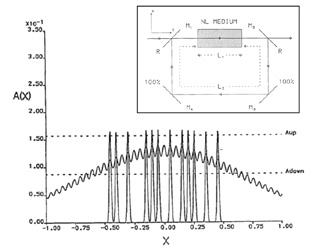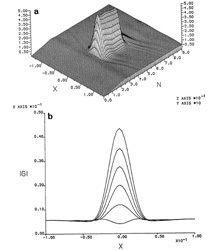Cavity solitons and soliton switching
Control of complexity (emergent universal patterns - solitons)
The work below includes the first proposal of control of spatial solitons - applications of complexity: controlling emergent universal patters (eg solitons) as pixels in information technology systems.
Soliton switching configuration
|
Soliton switching
|
||
|
|
Control of complexity - download early publications
8. GS McDonald, Reports on Study Centre Investigation Topics: i) Optical Collapse in Cavities / NLS with Pumping and Dissipation, Study Centre on Nonlinear Optics and Guided Waves, Edinburgh, UK, August 1-20, 1994.
7. PE Langridge, GS McDonald, WJ Firth and S Wabnitz, Self-sustained Modelocking using Induced Nonlinear Birefringence in Optical Fibres, Opt Commun 97 (1993) 178.
6. GS McDonald and WJ Firth, Switching Dynamics of Spatial Solitary Wave Pixels, J Opt Soc Am B 10 (1993) 1081.
Abstract. Separatrices and scaling laws in the switching dynamics of spatial solitary wave pixels are investigated. We show that the dynamics in the full model are similar to those in the plane-wave limit. Switching features may be indicated and explained by the motion of the (complex) solitary wave amplitude in the phase plane. We report generalization, into the domain of transverse effects, of the pulse area theorem for the switching process and a logarithmic law for the transient dynamics. We also consider, for what is the first time to our knowledge, phase-encoded address of solitary pixels and find that a near-square-wave temporal switching pattern is permitted without (transverse) cross switching.
5. GS McDonald and WJ Firth, All-optical Switching in a Nonlinear Resonator, J Mod Opt 37 (1990) 613.
Abstract. In this paper we consider some features of all-optical switching in a unidirectional ring cavity which is partially filled with a fast and saturably nonlinear medium . A comparative study of cross-talk for both signs of nonlinearity, in a two pixel (whole-beam switching) configuration, is made . A particular interaction modulation is discovered for two beams in the selfdefocusing case . For self-focusing media, results are extended by consideration of large (part-beam switched) solitary arrays . Prescribed binary patterns may be stably encoded in a single cavity transit which is in sharp contrast to the hundreds of transits required for spontaneous stabilisation . These patterns are seen to be stable over thousands of transits.
4. GS McDonald and WJ Firth, Pixel Dynamics in a Diffractively Coupled Bistable Array, Topical Meeting on Nonlinear Dynamics in Optical Systems, OSA, Afton, Oklahoma, USA, June 4-8, 1990.
3. GS McDonald and WJ Firth, Spatial Solitary Wave Optical Memory, J Opt Soc Am B 7 (1990) 1328.
Abstract. We consider some features of spatial solitary-wave switching in a unidirectional ring cavity that is partially filled with a fast and saturably self-focusing nonlinear medium. Large (part-beam switched) solitary arrays are considered. It is found that prescribed binary patterns may be encoded in the duration of a single cavity transit and subsequently remain stable over thousands of transits. Beam interrupt allows pixels to be switched off in fewer than ten cavity transits. Pixel instabilities on an unpixelated beam are shown to arise from spatial solitary attractive forces and intensity gradients.
2. GS McDonald, Spatial Solitary Wave Switching, Invited, Rank Prize Mini-Symposium on Nonlinear Optical Fibre Pulse Processing Grasmere, UK, Sept 10-13, 1990.
1. GS McDonald and WJ Firth, All-optical Switching in a Nonlinear Resonator National Quantum Electronics Conference, Oxford, UK, Sept 18-22, 1989.
Controlling complexity - further recent research
For further information, and an update on general research on cavity solitons, soliton switching, and control of complex systems - please see the FunFACS website hosted at the University of Strathclyde.